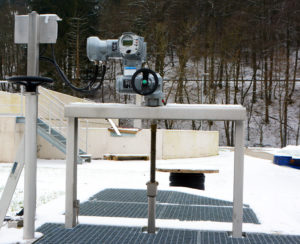PROFINET as an open Industrial Ethernet protocol is increasingly in demand in the water industry. Advantages like flexible network structure, easy handling, real-time capability, and powerful connectivity turn PROFINET into an ideal vehicle to increase the degree of automation and digitalization in the water industry. Especially in the context of Water 4.0, the digitalization initiative of the German water industry, innovative network technologies such as PROFINET play an important role in helping operators achieve sustainable plant operation and maximum risk reduction.
 AUMA recognized potential and has offered a PROFINET interface for its electric valve actuators since 2016. First field experiences confirmed the original expectations. The Marienheide Wastewater Treatment Plant(WWTP) in Germany, for example, has experienced remarkably high plant availability since installing redundant PROFINET systems to integrate field devices. Marienheide WWTP was the first plant to be equipped with PROFINET technology: since autumn 2017, around 20 AUMA actuators have been operating there in a PROFINET network at field device level.
AUMA recognized potential and has offered a PROFINET interface for its electric valve actuators since 2016. First field experiences confirmed the original expectations. The Marienheide Wastewater Treatment Plant(WWTP) in Germany, for example, has experienced remarkably high plant availability since installing redundant PROFINET systems to integrate field devices. Marienheide WWTP was the first plant to be equipped with PROFINET technology: since autumn 2017, around 20 AUMA actuators have been operating there in a PROFINET network at field device level.
The plant operator at Marienheide is the Wupperverband, a large German water association that operates 11 WWTP, 14 reservoirs, a sludge incineration plant, and numerous flood retention and rainwater catchment reservoirs.
“We expect high communication reliability due to the consistent use of PROFINET at both control system and field level,” explains Dirk Gengnagel, Group Leader Engineering and Organization in the Urban Water Management division of the Wupperverband. “Data and commands can be directly exchanged without any conversion, and PROFINET’s ‘integral redundancy’ function provides additional safety for plant availability. Furthermore, we expect savings and reduced proneness to faults since we can eliminate one bus level and require less hardware.”
Increased Availability and Easier Handling
At Marienheide, actuators are linked in a ring topology with intelligent switches using the Media Redundancy Protocol provided by PROFINET. The interface of each actuator has an integral switch function with two physically separate Ethernet ports. Should communication fail on one port, the other port will automatically be used. All actuators can still be addressed even if communication is interrupted at one point on the ring.
UV-resistant standard Ethernet cables were laid and connected via field-assembled RJ45 connectors. “In the past, when using a classic fieldbus system, we often faced problems with regard to physical layer, wiring, termination, EMC etc.,” reports Peter Pietrus, Technical Planner for Electronic Engineering at Wupperverband. PROFINET considerably reduces these issues.
Intelligent Networks and Diagnostics
The Wupperverband takes a positive view of PROFINET’s potential in preventive maintenance and improved data exchange. While classic fieldbus systems are limited to sharing data made available via the fieldbus protocol, PROFINET – as a true Ethernet standard – grants direct access to the diagnostic data of the actuator using a web browser, without overloading the DCS. Using PROFINET, important operating data such as temperatures and torque curves can also be read from the actuator. This improves the chances of detecting maintenance issues at an early stage.
Future-Proof Decision
The water industry very early on recognized the advantages of PROFINET for plant communication networks down to the field level. The industry is supported by device manufacturers such as AUMA who provide suitable field devices. As a result, the water industry has already started to benefit from this future-proof decision and the pioneering investments that have followed.
